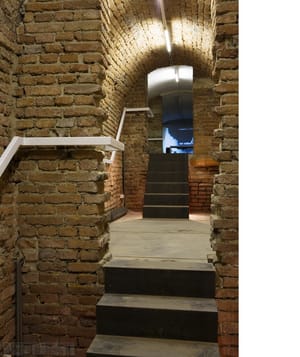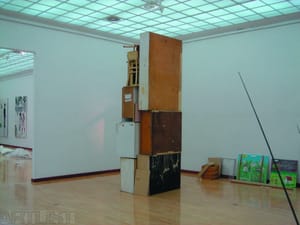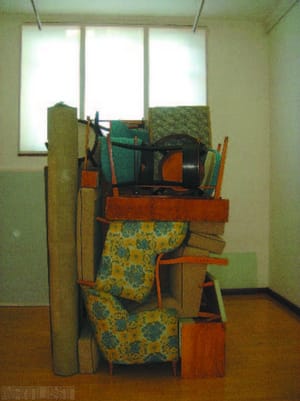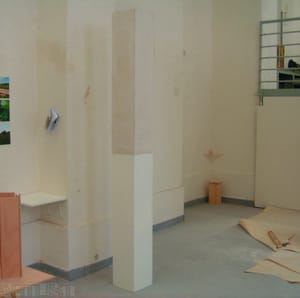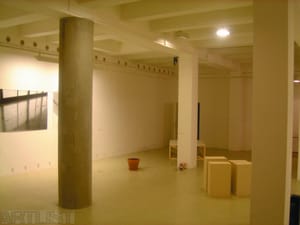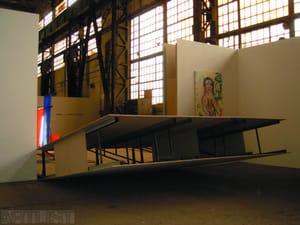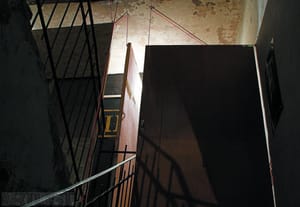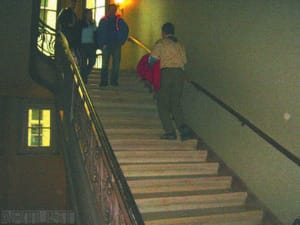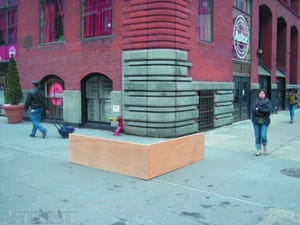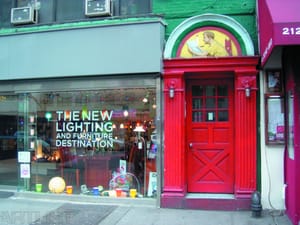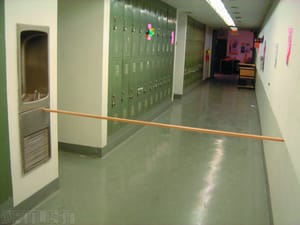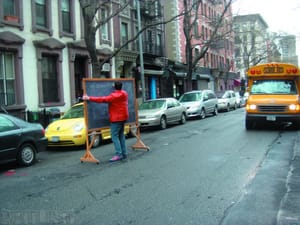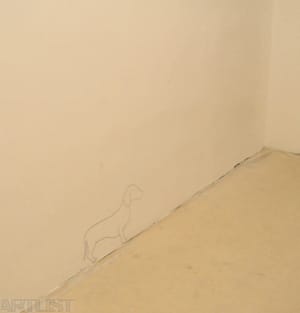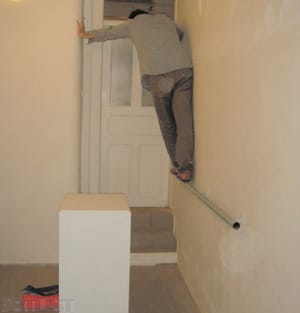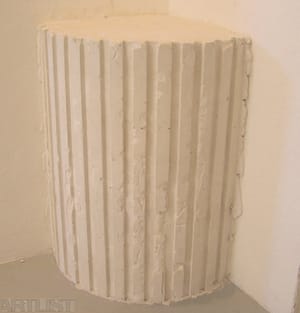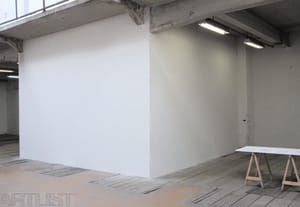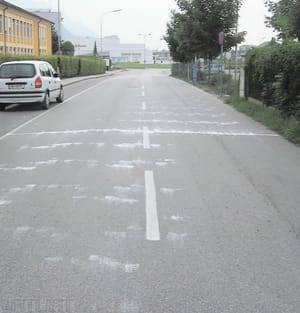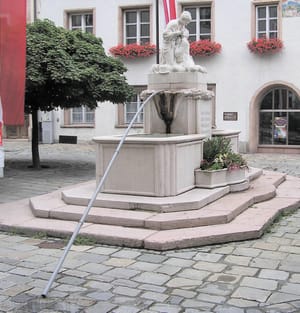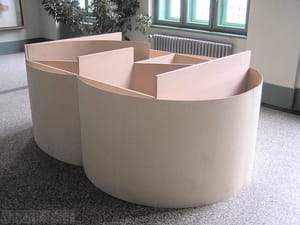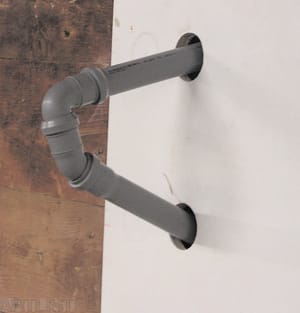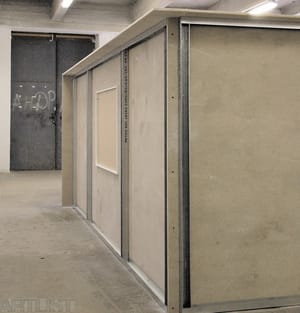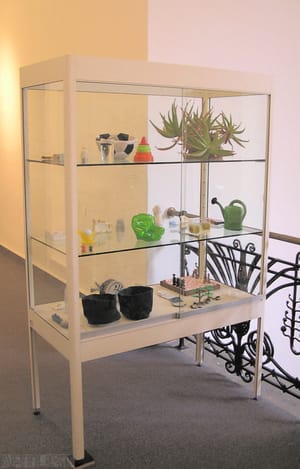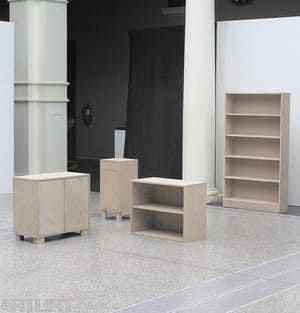- First Name
- Dominik
- Surname
- Lang
- Born
- 1980
- Birth place
- Praha
- Place of work
- Praha
- i-datum
- ↳ Find in the VVP AVU database
- CSU Library
- ↳ Find in the catalogue
About artist
Dominik Lang’s work takes in installations and objects, curation, exhibition architecture and occasionally classical sculptural work such as the creation of a monument. However, Lang is unlikely to create a monument in the form of a celebratory victorious figure. Sculpture for him is about the creation of a situation that reacts to a specific space. This is the principle that determines his installations, while at the same time serving to disclose hitherto unexpected or concealed connections, often historical or spatial. Situational sculpture, as we might call Lang’s work, introduced a new approach into a traditional artistic discipline that could only be fully and freely explored after the Velvet Revolution of 1989.
As well as his own sculptural work, Lang is also involved in exhibition architecture and gallery operations from the perspective of institutional criticism. In 2008, when he was curator of the Jelení Gallery, he occupied virtually all the roles that a gallery’s operations demand. Since 2011 he and Edith Jeřábková have headed the sculpture studio at the Academy of Arts, Architecture and Design in Prague.
While still a student at the Academy of Fine Arts in Prague, where he participated at several studios ranging from sculpture to new media, Lang began developing his conceptual approach. Using simple and often non-sculptural means he reacted to the immediate surroundings he found himself in most often. From 2004 to 2006 he carried out several interventions at the Academy itself (Díra z ateliéru / Work from a Studio, Schody / Stairs, Prádlo / Laundry). Most of these inhabit a space on the border of conceptual art and sculpture and possess an element of humour or irony, sometimes parodying the artistic process itself. His replica of the statue by Stanislav Kolíbal entitled Stavba / Construction caused a stir and raised questions regarding the concept of authorship and free use of the work of another artist. In many ways these are themes more applicable to the present time than to 2005, when the work was created. The redefinition of already existing artefacts and the search for their new meanings was also part of that aspect of Lang’s work touching upon the theme of Czech DIY and the aesthetics of normalisation.
One of Lang’s most striking achievements, which brought together several of the trends present in his work, was the installation Spící město / The Sleeping City at the Venice Biennale in 2011. At the heart of the project was a statue by his father Jiří Lang, which was taken to Venice where Lang worked on it in what was sometimes an almost morbid fashion. Statues were carved, completed, glued, enlarged or left in their original form and set within a staged space in which they blended with the carefully distributed furniture. In several cases a standalone artwork became simply the material for another statue. Lang’s manipulation of the work of another artist is reminiscent of the work already mentioned, including the reproduction and refashioning of works. However, in this installation the work already existed and the very fact that Lang decided to work with it created a new context in which a highly emotional level is connected up to general history. The collective clashes with the purely personal, and the history of post-war sculpture within which the statues were created with the story of a single hermetically sealed work. The dialogue between father and son is present, though the installation is more about dealing with the material and intellectual heritage surrounding Lang since childhood. We see a similar trajectory in the work of other Czech artists such as Petr Nikl, Markéta Othová and Martin Zet. However, in Spící město Lang was more radical both in expression and manner of presentation, which is irreverent and seemingly disrespectful to the original work. Dealing with the past by transforming it and situating it within completely new constellations then raises questions as to the value of sculptures from the period of normalisation, and as to how we should view artists of that time – albeit paradoxically through a devaluation of the sculptures themselves.
In other installations, too, Lang attempts to strike up a dialogue with modernist sculpture of the 20th century. At the Vienna exhibition Expanded Anxiety (2013) the viewer was invited to enter the interior of the statue Úzkost / Anxiety by Otto Gutfreund (created exactly one hundred years previously) and experience physically what the statue depicts. Lang transformed both entrenched and unchanged roles: the viewer/voyeur became a direct participant, and the statue became their space. He works in the opposite direction when creating site-specific installations in a gallery with a sculptural base. Lang avails himself of the character of the space in such a way that he supports a particular element. Despite the technical demands of the intervention the outcome is often so minimal that the viewer does not always see it, as for instance in the case of Světlík / The Light, which he created in the Václav Špála Gallery as part of the exhibition Vzpomínky na budoucnost / Memories of the Future (2009). In contrast, at the exhibition Procházení zdí / Walking Through Walls (2013) the transformation is acknowledged and foregrounded. Lang created a statue that encompassed the whole of the gallery in such a way that a single space arose subordinate to this statue composed of stereo-metric elements. The sculpture-installation becomes the focal point of the location, which it transforms perfectly by means of its presence.
A watershed in Lang’s work was the installation for which he won the Jindřich Chalupecký prize in 2013. Cutting the wall of Veletržní palác so that the visitor can observe the sunrise and sunset is such a ephemeral and time-limited experience that it cannot not be deemed a turning point. The use of the sun as the main driver of the work finds no parallel on the contemporary Czech art scene.
In the installation Dívka s holubicí / Girl with Dove he had a modernist sculpture of a girl, the icon of communist ideology that combines the symbol of peace, a dove and a child as a symbol of a radiant future, situated in a gallery, where it created all manner of situations. At the same time the actant and initiator was the sculpture itself as the extended hand of the artist, who completed the work in situ so as to be able to react directly to the space. As in previous installations, Lang was fascinated in movement itself, the experience and life of a sculpture in space.
In 2017 Lang created his first monument, and by doing so transcended the institutional framework within which he had until then operated. The Max van der Stoel monument is a complex example of Lang’s thinking. Instead of creating a material monument, an already existing element is used and elaborated upon, which in poetic metaphors recounts the historical moment that the work is intended to commemorate. In an interview for Revue Labyrint the artist said: “Sculpture seems to find itself at a crossroads. Neither the conceptual approach nor a neurotic adherence to the modernist tradition is sufficient.” This work demonstrates that a combination of both tendencies can even today represent a fruitful outcome that at the same time offers new perspectives on historical problems without copying by now hackneyed ways of thinking.
A no less important part of Lang’s output is exhibition architecture, which for him, as the creator of installations, is as important as the actual work displayed in it. At the exhibition Neklidná figura / The Restless Figure he drew on what had featured in Spícím městě. The main role here is taken over by an element that previously had been subordinate to sculpture, but here acquires a correlation with other phases of sculptural production, i.e. the plinth, pedestal or sculpture wheel. By virtue of the act of appreciating something that had always only ever served as a subsidiary means of displaying sculpture, this element enters into a new context, overturns and overhauls its own function, and reshapes established hierarchies in which the object of interest becomes an equivalent type of artefact.
- Author of the annotation
- Zuzana Krišková
- Published
- 2019
Dominik Lang draws upon the act of monitoring his immediate surroundings, which he completes (enhances) and modifies using installations and events. His concrete sources of inspiration are always tied to a combination of interest in production manner and the logic of the creation process. He notices how things are done, be it purchases in a plastic bag or a statue by Stanislav Kobal. Lang’s interest in the practical aspects of gallery operations is unique on the Czech scene. His subtle interventions create problems for the gallery space as such (Chatová osada – Cottage Settlement, VAU! – WOW!, 108,658245 m3) or they crush the viewer’s expectations of the gallery as a neutral „display window“ for art (Altán Klamovka – the Klamovka Gazebo, Česká republika – Czech Republic). In his project Udělali jsme téměř všechno pro změnu – "We did almost all we could for change" he addresses the exhibition process as the symbiosis of institutional roles (curator, exhibit architect, theorist, etc.). Lang’s favourite space is also his home Academy, which he disguises with simple interventions (i.e. made up expansion of the faculty by installing new cubby holes for faculty mail, installation of firebreaks in the entry hall, or drying laundry in the restroom window).
- Author of the annotation
- Zuzana Štefková
- Published
- 2006
CV
Studies:
2002-2008 Academy of Fine Arts in Prague
(ateliers of Jindřich Zeithamml, Veronika Bromová , Jiří Příhoda)
2004-2005 Academy of Applied Arts, Architecture and Design in Prague
(Jiří David)
Employment:
From 2012 Co-head (with Edita Jeřabková) of the atelier of sculpture at the Academy of Applied Arts in Prague
2008-2011 Assistant in the visiting professor’s atelier at the Academy of Fine Arts, Prague
2006 Assistant in the studio of Ai Weiwei, Peking, China
Awards, residencies, stipends:
2013 Jindřich Chalupecký Award
2010 Artist residency, Duende Gueststudios, Rotterdam, NL
2008 Artist residency, Zamek Ujazdowski, Warsaw, PL
2007 Leif Rumke Preis, DE
2007 Artist residency, IMPEX, Budapest, Hungary
2006-2007 The Cooper Union, New York
2005 International Summer Academy of Fine Arts, Salzburg
Exhibitions
- Solo exhibitions
-
2013
Expanded Anxiety, curated by Annette Suedbeck, Secession, Vienna, AU
Missing Parts, curated by Lydia Pribisova, The Gallery Apart, Rome, IT
2012
Humble Objects, curated by Petra Reichensperger, Kunsthaus Dresden - Galerie fuer Gegenwartskunst
/ Municipal Gallery for Contemporary Art, Dresden, DE
Images from the Exhibition, Galerie Cesar, Olomouc,
Working Model, Art Statements – Art Basel, with h u n t k a s t n e r, Basel, CH
The Lovers, Galerie Krobath, curated by Karel Císář, Vienna, AU
Documentation, h u n t k a s t n e r , Prague
Cause Investigation, Veletržní Palace, National Gallery, Prague
2011
Private Collection, Galerie Krobath, Berlin, DE
Local Museum, Galerie Kabinet T, Zlin
Sleeping City, curated by Yvona Ferencová, Czechoslovak Pavilion, 54th la Biennale di Venezia, Venice,
IT
2010
Wall, Gallery 99, DUMB: Brno House of Arts, Brno
2009
Storage, Karlín Studios, Prague
Architect (a selection of works), Gallery 99, DUMB: Dům umění v Brně, Brno
Visitor, Galerie Na bidlýku, Brno
Place for a Viewer, Yvona Ferencová , the Atrium at the Moravian Gallery, Brno
Three-Dimensional Geometry, GNF, Ústí nad Labem
2008
Between, Zamek Ujazdowski, Warszawa, PLhunt kastner, Prague www.huntkastner.com
2007
Things for Viewing and Walking Around, IMPEX, Budapest, HU
2006
Space Imagination, etc. galerie, Prague
Give Me the Brick, WNOD gallery, Prague
2005
Czech Republic, Gallery Jelení, Foundation and Center for Contemporary Art Prague
We Did Almost Everything (with Jiří Thýn), Entrance Gallery, Prague
Shopping Bag, Preproduction space - gallery, Berlin, DE
If this Procedure Should Fail, We Will Try Another (with Eva Koťátková), Galerie im Alcatraz, Hallein, AT
VAU !, Gallery Jeleni, Foundation and Center for Contemporary Art Prague
Cottage Settlement, Gallery of Young Artists, Brno
2004
Dyzajn blok, Goethe-Institut, Prague
- Group exhibitions not included in ARTLIST.
-
2013
I Salute the Potter’s Clay, with Tom Godfrey, Karol Radziszewski, Marie Lund, Yonatan Vinitsky,
curated by Eve Smith and Gemma Lloyd, Czarna Gallery, Warsaw, (forthcoming April 2013)
2012
The Beginning of the Century, curated by Pavlina Morganová, Pilsen Regional Museum, Pilsen
Intense Proximity, La Trienniale, curated by Okwui Enwezor, Palais de Tokyo, Paris, FR
Between the First and Second Modernity, 1985-2012, curated by Edith Jeřabková, and Jiří & Jana
Sevčik, National Gallery in Prague at the Veletržní Palace, Prague
2011
Auxiliary Constructions - Behilfskonstruktionen, curated by Petra Reichensperger, KunsthausDresden -
Staedtische Galerie fuer Gegenwartskunst / Municipal Gallery for Contemporary Art, Dresden, DE
Finalists of the 2011 Jindřich Chalupecký Award, Dox, Prague
Les amis des mes amis sont mes amis, hommage a Ján Mančuška, Galerie Jocelyn Wolff, Paris, FR
Sculpture in the Street, curated by Karel Císář, DUMB: Dům umění v Brně, Brno
Zentrum (with M.Geiger & M. Mazanec), Czech Center Vienna & Austrian Cultural Forum, Prague
The Art of Urban Intervention, Emil Filla Gallery, Ustí nad Labem
2010
Don't Forget the Flowers, curated by Yvona Ferencová, Moravian Gallery, Brno
One Day You Will Lose It All, 4+4+4 Days in Motion Festival, Prague
5
th Biennale of Young Artists, curated by Tomáš Pospisžyl, House of the Stone Bell, Prague City Gallery
City, Prague
Dziewiec tytulow, BWA Zielona Gora, PL
Boundary, Gallery NoD, Prague
2009
After Velvet, long-term exhibition, Prague City Gallery, House of the Golden Ring, Prague
White Paper, Black Bride, curated by Jiří Kovanda & Edita Jeřabková, Prague Biennale 4, Karlín Hall,
Prague
Zlin salon of Young Artists, Zlin
Easy Actions Without a Clear End / Azioni molto semplici senza uno scopo preciso, Artra, Milano, IT
Lived In Spaces, Krajska galerie Zlín
Memories of the Future, curated by Karel Císář, Galerie Vacláv Špála, Prague
Brno Art Open 2009, DUMB: Dům umění v Brně, Brno
2008
Bewohnte Orte, Illusionen über die Stadt und das Land , Kunstverein Springhornhof, Neuenkirchen,
Neuenkirchen, DE
Love at First Site, curated by Emanuela Nobile Mino, Gallery Futura, Prague
MANUAL CC, Instructions for beginners and advanced players, CSW Centrum Sztuki Wspolczesnej /
Centre for Contemporary Art Ujazdowski Castle, Warszawa, PL
Contemporary Czech Cubism, curated by Václav Magid, Old Town Hall, Prague City Gallery, Prague
Move On, Galley Futura, Praguehunt kastner, Prague www.huntkastner.com
Výstava Humhala, Galerie Jelení - Center for Contemporary Art, Prague
Archive, (with Jiří Hůla), inaugural exhibition of DOX - Centre for Contemporary Art, Prague
2007
GNP2, curated by William Hollister, Mars Gallery, Moscow, RU
Hygiena, galerie Puda, Jihlava
The Collectors: Live Re-Edit, curated by Jiří Ptáček, Dům panů z Kuštát, Brno
Leif Rumke Award, ZKMax, Munich, DE
Glocal Outsiders, curated by Jiří David & Vasil Artamonov, Praguebiennale 3, Karlin Hall, Prague
GNP, curated by Kryštof Kintera, Municipal Library, Prague City Gallery, Prague
Invisible Things, Trafo Gallery, Budapest, HU
Essl Award Finalists, Gallery at the Academy of Fine Arts, Prague
2006
Sell Me Buy Me, galerie U dobrého pasťye, Brno
Finalists of the 2006 Jindřich Chalupecký Award, DUMB: Dům umění v Brně, Brno
I Invited a Few Friends to Come and Watch, curated by Galerie Display, Galerija Nova / Galerija M.
Kraljevice, Zagreb, HR
Indikace, 4+4+4 Days in Motion Festival, Prague
Martian Fields, Galerie Mars, Moscow, RU
Eternal States, Karlín Studios, Prague
Gruppen Ausstellung: Gorkiewicz, CHEEK, Lang, Meduna, Petiletá, Wolff, curated by Jiří Ševčik,
Austrian Cultural Forum, Prague
Office Art, curated by Zuzana Štefková, galerie c2c, Prague
Gallery Continua, 798, Peking, China
Tannoy, Terrace, London, UK
The Enormous Space, Galerie C2C, Prague
2005
1811197604122005, curated by Galerie Display, Plan B, Cluj, RO
Essl Award Finalists, Academy of Fine Arts Gallery, Prague
Fear in the City, Galerie kritiků, Prague
Contact 2005, Galerie Klatovy, Klenová
- Other realisations
Curatorial activities:
2007-11 curator of the exhibition program at Galerie Jelení, Prague, CZ
Monography
- Articles
Jiří Ptáček, Umělec 1/2006 Markéta Kubačáková, Galerie, A2 kulturní týdeník, 19/ 2008, s. 26-27 Monika Ticháčková, Zamilovat se do prostoru?, A2 kulturní týdeník, 31/ 2008 Jakub Stejskal, Mimetické inverzní vzpomínání, A2 4/09
- Other critical texts
- Personal texts not included in database
My work mainly deals with explorations of the public space, reactions
on concrete situations and perception of the contemporary sculpture in general. I do not make remarkable, individual projects which would show their originality, there is more of the consistant attitude and working method in it. I am focused on revealing the solutions. My objects and installations are usually formally very precise,made out of everyday materials,they move on the boarder between art and design and craft. My work can be summarized as a program: Important connecting link and repeating theme in my works is the idea of wasting time, space and effort in the process of making . Many of my installations and interventions are results of a time-consuming and hardworking process, the installation very often serves as a proof or result of the action. The final appearance of the objects is usually very minimal,
sometimes maybe even invisible. I am interested in how things are made and for which purpose they constitute a means, I am concerned in a play with different materials and their physical and optical quality, stability, divisions of space which unables fluent movement, subtle modificaftions of objects,
changes of scale, newly defined functions and characteristics of things,taking already made objects out of their natural contexts and using them for other purpose, so that they are loosing their previous function and meaning. The projects vary from removing selected sections, interrupting the stability of an apparently homogenous space, infirming the viewer and playing with his/her reaction (which i also take as one of the results of my work) The place of my actions is usually and logically my nearest neighbourhood-school, home, public space.The content of the work is strictly given by its context. One of the outputs of my work is a level of the personal experience. The installations rise from the idea of some concrete space or situation-interior of a gallery or eaction on a concrete stereotype. Some of them are very temporal, they serve to raise questions about our conventional system,the social cathegories such as private and public can be rethought. I focus on relationship between object and space, object and the viewer etc. Influenced by minimalism, design, architecture, ready made, the aesthetic of cheap material, I conduct
my ironic game with apparently stable concepts such as big and small, banal and sublime, true and false.




